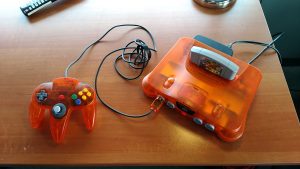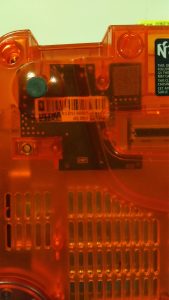Time-Travel or Undead Media – The NecRomantic Modification of Hardware: A Possible Interface Between the Metagame and Platform Studies
Towards the end of the introduction to Metagaming: Playing, Competing, Spectating, Cheating, Trading, Making, and Breaking Videogames, Boluk and Lemieux note the messiness of the eponymous term. It is expansive, broadly inclusive. The metagame temporally and spatially encloses, projects from, penetrates, and anchors the game into social, political, and economic structures (Boluk and LeMieux 11). They touch on two variants of Garfield’s definition of the metagame, a published and an unpublished version, from the text of a talk he gave. The published version is: “how a game interfaces beyond itself”. The unpublished version: “how a game interfaces with life” (Boluk and LeMieux 14, italics in the original). So the key is that the metagame is the way by which a game interfaces in an omnidirectional way.
Now although Boluk and LeMieux do mention modifications to play, such as speed runs, they don’t go the opposite direction, ‘inward’ so to speak, into the hardware. Hardware does not seem to be included in the ‘interface with life’, or they’re sticking to a game design philosophy, and want everything to be centred on the game. They do note and lament the synonymy of the game with hardware warranties, which is interesting in that warranty foreshadows obsolescence, which is something I’ll get to. But I think they’d do themselves a disservice to ignore something like a culture of console modification, which would fit into their notion of metagames as interfacial and characterized by relation. I think this would also converge with Platform Studies nicely, insofar as Platform Studies is concerned with the relations between hardware and software, as Bogost and Montfort describe (5). Metagames and platform studies might converge at relations. The rest of this probe will attempt to examine this convergence alongside the notion of hardware obsolescence vs. update.
The photo above is of a modified Nintendo 64, with an UltraHDMI chip installed into it. The chip was created by MarshallH of http://ultrahdmi.retroactive.be/. The chip (shown in the image at right) allows the N64 to be played on contemporary televisions via HDMI, processing the video signal digitally, which depending on the settings you use, will give you less lag and a clearer image than you might otherwise get. Further, the HDMI chip implies and allows for a few interesting relations and mutations. First off, you buy an installation kit from various vendors, and there are different modders offering installation services, and some offering both purchase of the installation kit and installation on your working console. The chip adds an on-screen display, through which one can change various display options. Without going into full detail, there are about 30 different options added by the HDMI chip. That’s just the individual options, not the possible combinations. There’s a “Retro Mode” which, as per MarshallH’s manual: “Applies a set of tweaks to mimic gameplay on a typical 90s television” (Quick Start Guide). If you turn on Retro Mode, you can then tweak those tweaks further, to your liking, to best suit your television. What this ends up doing is to alter the video output on your TV in ways that would have never been possible on an older TV with an unmodded console a couple decades ago. Scanlines wouldn’t have been visible on most televisions when the N64 first came out, but the UltraHDMI chip allows you to apply them. One interesting example noted by Youtuber phonedork: when scanlines are enabled in DOOM, already a dark game where you have to turn up the brightness to really even see at all at some points, the scanlines make this game even DARKER—this nostalgic hallucination darkens the play experience. But if you turn on the Integer setting, you can see the game in a way you never would have on the ‘original,’ on an older TV, and it becomes more playable.
The HDMI chip is a kind of polymorphic implementation for the console’s video display, which allows for a produced nostalgia. A mutant or fictional archaeography perhaps is written. It is an act of preservation, an attempt to avert the inevitable decline into technical obsolescence, and it has all sorts of relations swirling around it. So the N64 and any games played on it are pulled forward in this altered, haunted kind of way.
Now, back to the messiness of Boluk and LeMieux’s metagame. They note that changing the game mechanics, editing code, changes the game and they seem to discount this from their notion of the metagame (Boluk and LeMieux 9). A hardware mod such as I’ve described above may fall into this. But they seem to want the following:
[…]alternate histories of play defined not by code, commerce, and computation but by the diverse practices and material discontinuities that emerge between the human experience of playing videogames and their nonhuman operations. Metagames transform videogames from a mass medium and cultural commodity into instruments, equipment, tools, and toys for playing, competing, spectating, cheating, trading, making, breaking, and ultimately intervening in the sensory and political economies of those technologies responsible for the privatization of play. (Boluk and LeMieux 4)
The modification of the console creates visually mutated forms of any game played with it, an alternate history for the games and the console, and the chip itself allows for the continued existence and graphically altered (polymorphed) play (an(after)life of the console), when this object might otherwise be amputated by the harsh onward march of tele-tech development. The chip marks one of these material discontinuities, and if one were to posit a point of resistance, if one felt that resistance against neoliberal capitalist domination were possible, than the modification of the console might be one.
Platform Studies as defined by Bogost and Montfort would draw this out. They note Marc Andreesen’s description of the platform as able to be altered and adapted in ways unforeseen by the developers, for “countless” new “needs and niches” (Bogost and Montfort 3). They further note:
Platform studies is about the connection between technical specifics and culture[…] how particular aspects of a platform’s design influenced the work done on that platform—for instance, how the presence of a particular graphics mode enabled games of a certain sort to be made[…] at how social, economic, cultural, and other factors led platform designers to put together systems in particular ways. (Bogost and Montfort 4-5)
I think you could add console modders alongside platform designers in this definition as a focus for platforms studies. Further, I think this modified console, or this kind of console modification in general, does sit on a weird spot between platform studies and the metagame and the larger corporate video game space. By Boluk and LeMieux’s definition of what metagames are, this kind of modification and it’s productions and community would need to be examined. It’s unlikely that hardware could be amputated from a study of the metagame. Hardware modification spawns graphical mutations, cultures of review, spectatorship, competition, and economy that in important ways try to step outside of the corporate space and dodge the possibility of obsolescence that an object like an N64 experiences as it’s IP-holder moves on to new products. Platform studies and metagame studies are going to need each other.
Works Cited
Bogost, Ian, and Nick Montfort. “Platform Studies: Frequently Questioned Answers.” Proceedings of the Digital Arts and Culture Conference, 2009 – after media: embodiment and context. UC Irvine, 2009.
Boluk, Stephanie, and Patrick LeMieux. Metagaming: Playing, Competing, Spectating, Cheating, Trading, Making, and Breaking Videogames. U of Minnesota P, 2017.
phonedork. “Classic Gaming on a Sony BVM20F1U, Ultra HDMI, and HIDEF NES.” Youtube. https://youtu.be/3yeKMo6mcAo?t=750. Accessed 10 November 2017.
“Quick Start Guide.” Retroactive, http://ultrahdmi.retroactive.be/installer_files/quick_start.pdf. Accessed 10 November 2017.


